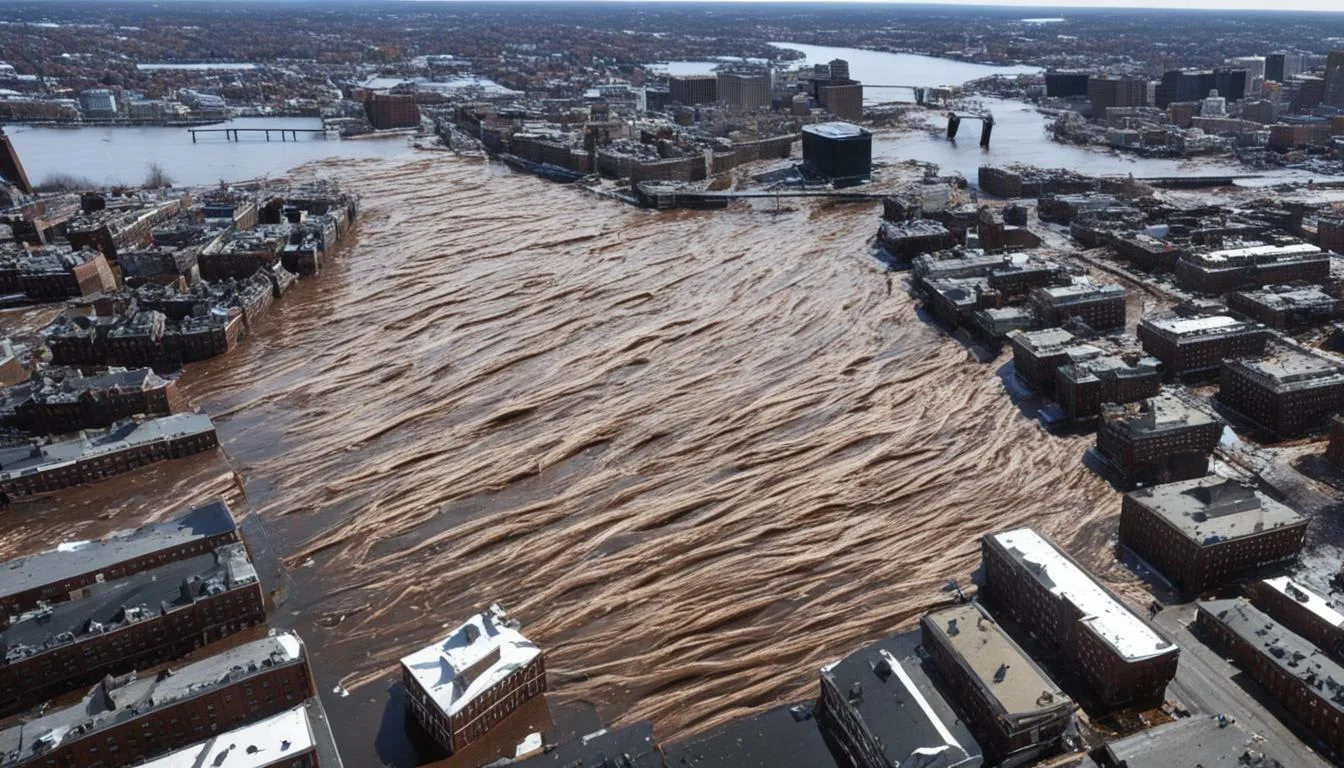The Incredible Story of the Boston Molasses Flood
The Boston Molasses Flood, also known as the Great Molasses Flood, was a bizarre and deadly industrial accident that occurred on January 15, 1919, in the North End neighborhood of Boston, Massachusetts. A massive storage tank containing over 2 million gallons of molasses suddenly burst, unleashing a massive wave of the sticky substance that devastated the surrounding area. The flood caused immense destruction, resulting in the deaths of 21 people and injuring over 150 others. This incredible story is a unique and captivating piece of American history.

The Boston Molasses Flood
"Chaos and destruction caused by a massive wave of thick, brown molasses sweeping through the streets of Boston. Buildings and infrastructure crumble as the viscous flood engulfs everything in its path."
Key Takeaways
The Boston Molasses Flood was a bizarre and deadly industrial accident that occurred in 1919.
A massive storage tank containing over 2 million gallons of molasses suddenly burst, unleashing a devastating wave.
The flood caused immense destruction, resulting in 21 deaths and over 150 injuries.
This event is a unique and captivating piece of American history.
The Great Molasses Flood has become a symbol of the importance of safety regulations and corporate responsibility.
The Boston Molasses Flood: A Sticky Disaster
The Boston Molasses Flood was a truly remarkable event that has captured the public's imagination for decades. On that fateful day in 1919, a large molasses storage tank, owned by the Purity Distilling Company, suddenly ruptured, unleashing a massive wave of the sticky, sweet substance. The sheer force of the molasses flood caused immense destruction, toppling buildings, crushing people, and leaving a sticky mess in its wake. This bizarre and deadly industrial accident has become a unique and enduring part of Boston's history.
The Great Molasses Flood, also known as the Boston Molasses Disaster or Molassacre, was a catastrophic event that left an indelible mark on the city. The molasses spill was so significant that it became a part of the city's cultural fabric, with the molasses tragedy being remembered and retold for generations. The Boston harbor disaster served as a reminder of the importance of safety regulations and corporate responsibility, and the lessons learned have echoed through the decades.
While the Boston Molasses Flood may have been a bizarre and unlikely event, its impact on the city and its residents was very real. The sheer scale and destruction of the molasses explosion left an indelible mark on the community, and the heroic efforts to rescue survivors and clean up the sticky mess have become part of the city's enduring legacy. Today, the historical event stands as a testament to the power of nature and the importance of vigilance in the face of industrial hazards.
Setting the Scene: The Fateful Day
A Warm Winter's Day in Boston
On January 15, 1919, the city of Boston was experiencing a rare warm winter day, with temperatures reaching nearly 40°F. The mild weather was an unusual respite from the typically frigid New England winters, providing a pleasant backdrop for the unsuspecting residents of the North End neighborhood.
The Looming Molasses Tank
In the North End, a massive 50-foot tall molasses storage tank owned by the Purity Distilling Company loomed over the community. This tank, which held over 2 million gallons of the sticky, brown liquid, was a familiar sight to the local residents. However, unbeknownst to them, the tank was in a state of disrepair and was about to unleash a devastating deluge upon the unsuspecting neighborhood.
The Molasses Deluge: Chaos Unleashed
On that fateful day in 1919, the weakened structure of the massive molasses tank suddenly gave way, causing the colossal container to rupture with a resounding explosion. The resulting tidal wave of molasses surged through the streets of Boston's North End at an estimated speed of 35 mph, forming a 15-foot-high wall of the sticky, brown liquid. The molasses deluge demolished buildings, swept away vehicles, and engulfed everything in its path, leaving a trail of devastation in its wake.

The Burst and Tidal Wave of Molasses
The sheer force of the molasses flood was truly astonishing. Eyewitnesses described the scene as a "gigantic brown wave" that crashed through the neighborhood, leaving a trail of destruction in its path. The molasses tidal wave tossed railroad cars like toys, toppled buildings, and trapped unsuspecting residents in the sticky mess. The impact was so severe that the molasses flood is now remembered as one of the most unique and tragic industrial accidents in American history.
The Devastating Impact on the Neighborhood
The aftermath of the Boston molasses flood was nothing short of catastrophic. The 21 people who lost their lives and the over 150 others who were injured were a testament to the immense power of the molasses deluge. Homes, businesses, and infrastructure were decimated, leaving the community reeling from the devastation. The clean-up efforts in the aftermath would be a Herculean task, as the thick, sticky molasses had to be removed from the streets and buildings, a process that would take weeks to complete.
the boston molasses flood
A wave of molasses engulfing a crowded street, buildings and people swept away in its thick brown current. The chaos and destruction caused by the unleashed deluge, with splashes of molasses and debris suspended in mid-air. The scene is surreal, yet terrifyingly real. The Boston Molasses Flood has left its mark on the city forever.
Aftermath: Cleaning Up the Molassacre
In the aftermath of the Boston Molasses Flood, rescue efforts were immediately underway to save those trapped in the debris and recover the bodies of the victims. Firefighters, police, and community members worked tirelessly to search through the molasses-covered wreckage for survivors of this historic industrial accident.
Rescuing Survivors and Recovering Bodies
The task of locating and extracting those caught in the flood's destruction proved incredibly challenging. The thick, sticky molasses had engulfed the area, making it difficult for rescue teams to navigate and access potential victims. Undeterred, they worked around the clock, carefully sifting through the molasses-soaked ruins, eventually recovering 21 fatalities and treating over 150 injured individuals.
The Herculean Task of Removing the Molasses
With the rescue efforts complete, the community faced the daunting challenge of clearing the molassacre from the streets and buildings. Trucks, shovels, and even steam hoses were employed to tackle the Herculean task of removing the solidified molasses that had blanketed the neighborhood. The cleanup operation stretched on for weeks, as crews worked tirelessly to restore the area to its pre-disaster state.
Despite the overwhelming scale of the Boston Molasses Flood, the resilience and determination of the community shone through in the aftermath. The cleanup efforts, while arduous, ultimately helped the North End of Boston recover from this unique and unexpected industrial accident that had become a tragic part of the city's historical event.

Molasses cleanup
Show a group of workers using hoses and shovels to scrape off sticky brown molasses from the streets and buildings after the Boston Molasses Flood. The sun is setting behind them, casting an orange glow on the scene. Piles of molasses-coated debris are visible in the background, including overturned carts and twisted metal. There is a sense of urgency in their movements as they work to clear the mess before it hardens.
Investigating the Cause: A Tale of Negligence
As the city of Boston began to recover from the devastating Boston Molasses Flood, investigations were launched to determine the root cause of this tragic disaster. It soon became apparent that the storage tank at the heart of the incident had been poorly constructed and lacked adequate maintenance and oversight.
Faulty Construction and Oversight
The investigation revealed that the storage tank's walls were only 1/8 inch thick, far too thin to withstand the immense pressure of the 2.3 million gallons of molasses it contained. Additionally, there were concerns that the tank had been intentionally overfilled, contributing to the sudden and catastrophic rupture.
Legal Battles and Accountability
In the aftermath of the great molasses flood, the Purity Distilling Company, the owners of the ill-fated storage tank, faced a barrage of lawsuits from the victims and their families. This complex legal battle would drag on for years, with the company ultimately found liable for the tragedy. The Boston Molasses Flood served as a tragic lesson in the importance of strict safety regulations and the need for corporate responsibility.
FAQ
What was the Boston Molasses Flood?
The Boston Molasses Flood, also known as the Great Molasses Flood, was a bizarre and deadly industrial accident that occurred on January 15, 1919, in the North End neighborhood of Boston, Massachusetts. A massive storage tank containing over 2 million gallons of molasses suddenly burst, unleashing a massive wave of the sticky substance that devastated the surrounding area.
How much damage did the molasses flood cause?
The flood caused immense destruction, resulting in the deaths of 21 people and injuring over 150 others. The sheer force of the molasses wave toppled buildings, crushed people, and left a sticky mess in its wake.
What caused the molasses tank to burst?
Investigations found that the storage tank had been poorly constructed and lacked proper maintenance and oversight. The tank's walls were only 1/8 inch thick, far too thin to withstand the immense pressure of the 2.3 million gallons of molasses it contained. Additionally, there were concerns that the tank had been overfilled, contributing to the sudden rupture.
How did the community respond to the disaster?
In the aftermath of the Boston Molasses Flood, rescue efforts were immediately underway to save those trapped in the debris and recover the bodies of the victims. Firefighters, police, and community members worked tirelessly to search through the molasses-covered wreckage for survivors. The task of removing the thick, sticky molasses from the streets and buildings was immense, requiring a Herculean effort from the cleanup crews.
What were the legal consequences of the Boston Molasses Flood?
The Purity Distilling Company, the owners of the storage tank, faced numerous lawsuits from victims and their families, leading to a complex legal battle that would last for years. The Boston Molasses Flood served as a tragic lesson in the importance of safety regulations and corporate responsibility.
Like this project
Posted May 21, 2024
wrote this article on The boston molasses flood
Likes
0
Views
10
Tags



